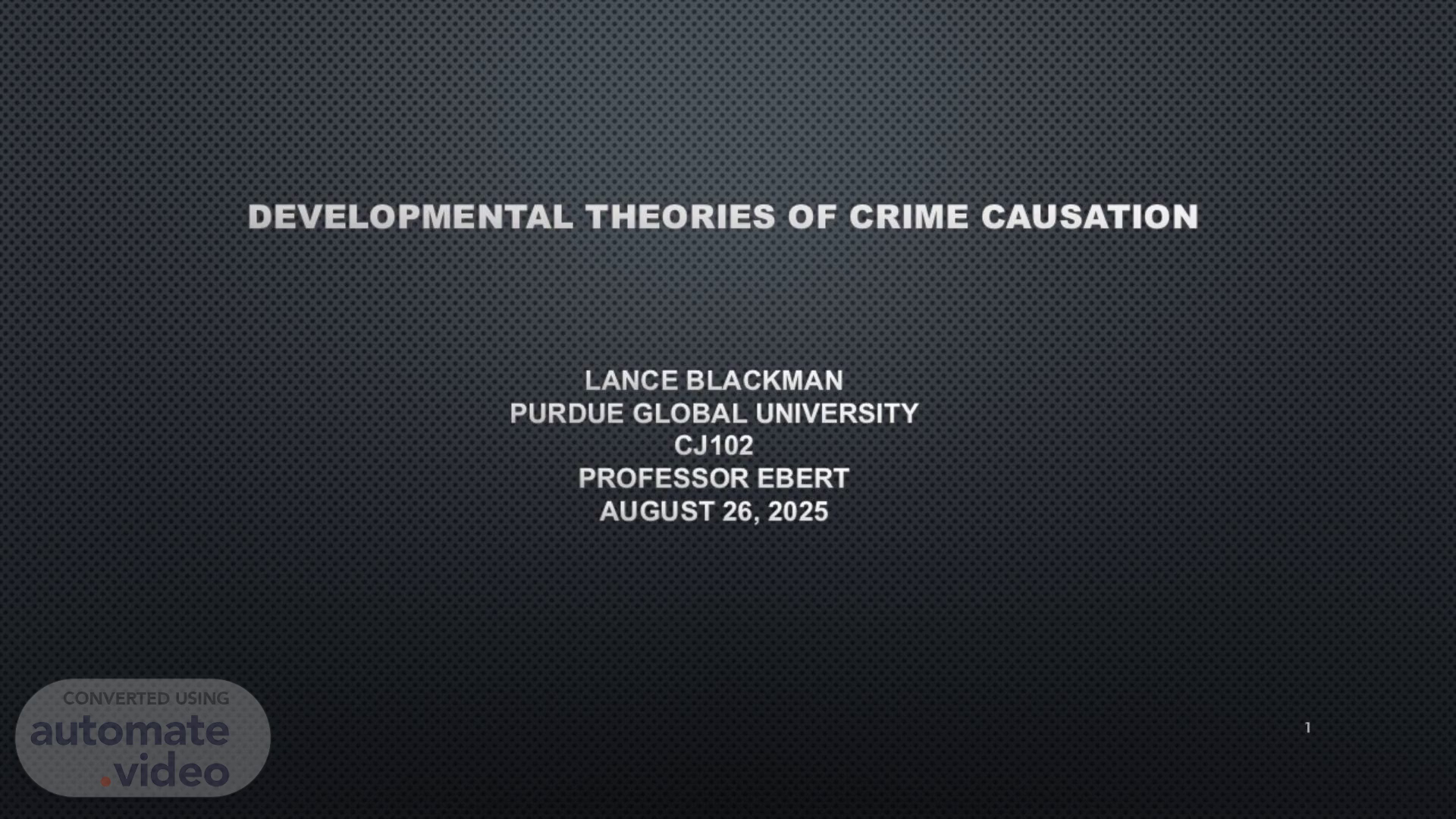
Developmental Theories of Crime Causation Lance Blackman Purdue Global University CJ102 Professor Ebert August 26, 2025
Scene 1 (0s)
[Audio] Welcome to my presentation on developmental theories of crime causation. Today we will explore three major theories that help explain criminal behavior, examine Cohen's Theory of Delinquent Subcultures, and analyze Anderson's Code of the Streets with current real-world applications. These theoretical frameworks provide essential perspectives for understanding how criminal behavior develops and persists in society, offering valuable insights for criminal justice professionals and policymakers..
Scene 2 (32s)
[Audio] To understand why people commit crimes, it's important to look at different theories that offer various viewpoints on what drives criminal behavior. Biological theories consider things like genetics and biology, psychological theories dig into mental processes and personality traits, while sociological theories explore how social settings and cultural influences shape behaviors. Nowadays, criminology tends to see these factors as interconnected, meaning that crime usually comes from a blend of individual traits and environmental influences. This presentation will mainly focus on sociological approaches, especially how social conditions can create subcultures that might encourage criminal activities..
Scene 3 (1m 20s)
[Audio] Over time, ideas about how biology affects behavior have changed a lot. We've moved from thinking genes determine everything to more nuanced views that see how biological factors mix with our surroundings. These theories look at stuff like brain issues, hormone levels, diet, and how our brains are wired, all while considering the impact of family and neighborhoods on behavior. On the other hand, psychological theories dive into how our minds work. They cover everything from psychoanalysis, which digs into childhood experiences, to behaviorism, which focuses on how we learn from others, and cognitive theories that explore how what we perceive shapes our actions. Both sides have shifted from a simplistic view to recognizing that crime often results from a mix of personal traits and social influences..
Scene 4 (2m 13s)
[Audio] Sociological theories examine how social structures, economic conditions, and cultural factors create environments that either promote or discourage criminal behavior. These theories argue that crime is not simply an individual choice but a product of social forces including poverty, inequality, social disorganization, and cultural conflicts. Subcultural theories, which we'll examine in detail, suggest that criminal behavior often represents a rational adaptation to social conditions that block access to conventional success. Understanding these social dynamics is crucial for developing effective crime prevention strategies that address root causes rather than just individual behaviors..
Scene 5 (2m 58s)
[Audio] Albert Cohen's 1955 theory explains juvenile delinquency through social class conflict and status deprivation. Working-class boys face "status frustration" when unable to meet middle-class standards emphasized in schools and other institutions. These standards include academic achievement, delayed gratification, and conformity to authority. When consistently failing to meet these expectations, boys experience rejection and inadequacy. Rather than accepting failure, they engage in "reaction formation," completely rejecting middle-class values and forming oppositional subcultures with inverted norms. This explains why much juvenile delinquency appears "non-utilitarian" - it serves to gain status within the delinquent subculture rather than material benefits..
Scene 6 (3m 51s)
[Audio] Elijah Anderson's 1999 study in Philly's tough neighborhoods looked into the unwritten rules about how people act on the streets. He split the community into two groups: "decent" families who try to hold on to mainstream values despite struggling financially, and "street" families who go with the street culture to get by. The main idea of this code is all about "respect"—protecting your reputation at all costs. This means you've got to be tough, both physically and mentally, and if someone disrespects you, you have to respond right away to avoid looking weak and getting pushed around more. Not everyone totally buys into this code, but most folks have to deal with its rules to stay safe in places where the police aren't really doing their job..
Scene 7 (4m 36s)
[Audio] Anderson's Code of the Streets theory still makes a lot of sense when it comes to understanding urban violence today, especially how social media has changed the game. Now, online disrespect—like rude posts, videos, and comments—is a huge driver of gang-related violence. The idea that you have to retaliate when someone disrespects you has become even more intense in the digital world, where something embarrassing can blow up on the internet in no time. This leads to "digital-to-physical violence cycles," where online insults can quickly turn into real-life fights. Traditional law enforcement methods often miss the mark because locking someone up might actually boost their street reputation instead of deterring them. That's why some police departments are starting to try community intervention programs that tackle these respect issues at their core..
Scene 8 (5m 32s)
References Anderson, E. (1999). Code of the street: Decency, violence, and the moral life of the inner city. W. W. Norton & Company. Cohen, A. K. (1955). Delinquent boys: The culture of the gang. Free Press. Hyatt, J. M., Densley, J. A., & Roman, C. G. (2021). Social media and the variable impact of violence reduction interventions: Re-examining focused deterrence in Philadelphia. Social Sciences, 10(5), 147. https://doi.org/10.3390/socsci10050147 Nickerson, C. (2024, February 13). Subcultural theories of deviance. Simply Psychology. https://www.simplypsychology.org/subcultural-theories-crime-deviance.html Siegel, L. (2022). Criminology (8th ed.). Cengage Learning US. https://purdueuniversityglobal.vitalsource.com/books/9798214341149.